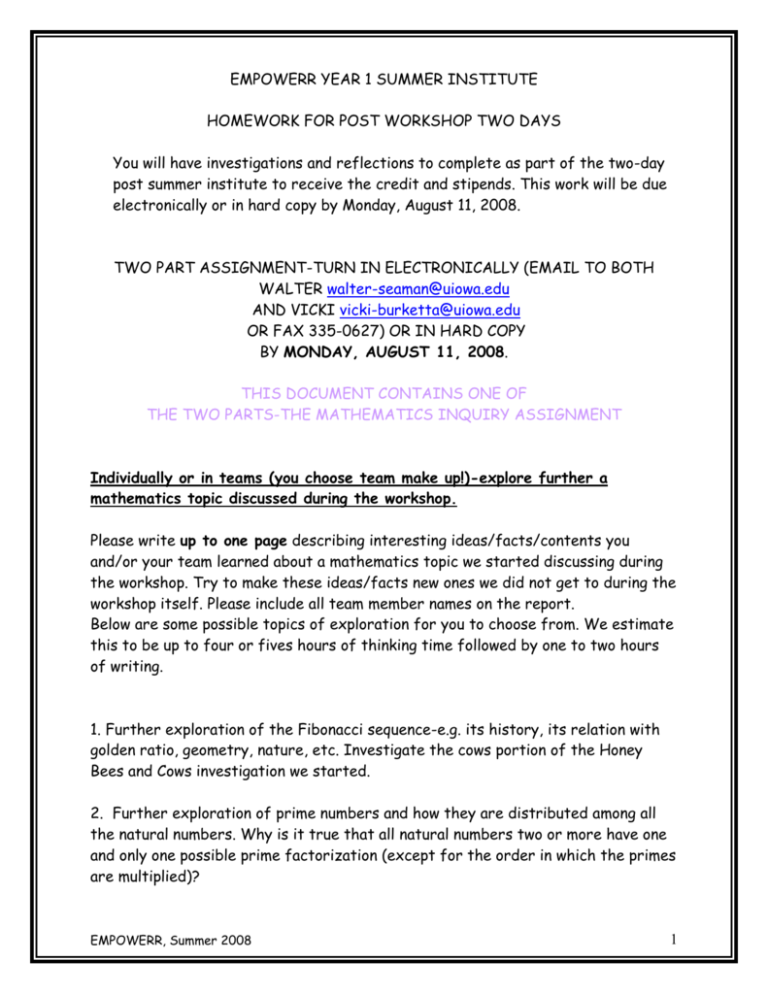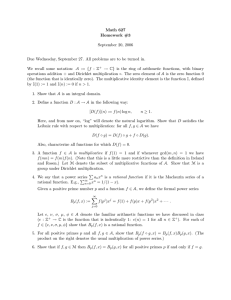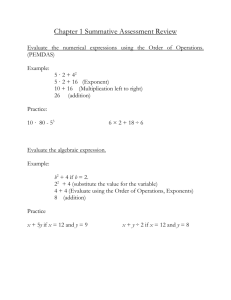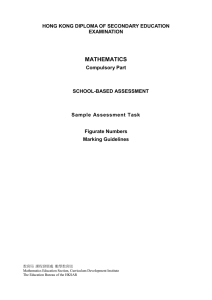04 MathInquiry-HwkFor2DaysAfterWkshp-08-04-08
advertisement

EMPOWERR YEAR 1 SUMMER INSTITUTE HOMEWORK FOR POST WORKSHOP TWO DAYS You will have investigations and reflections to complete as part of the two-day post summer institute to receive the credit and stipends. This work will be due electronically or in hard copy by Monday, August 11, 2008. TWO PART ASSIGNMENT-TURN IN ELECTRONICALLY (EMAIL TO BOTH WALTER walter-seaman@uiowa.edu AND VICKI vicki-burketta@uiowa.edu OR FAX 335-0627) OR IN HARD COPY BY MONDAY, AUGUST 11, 2008. THIS DOCUMENT CONTAINS ONE OF THE TWO PARTS-THE MATHEMATICS INQUIRY ASSIGNMENT Individually or in teams (you choose team make up!)-explore further a mathematics topic discussed during the workshop. Please write up to one page describing interesting ideas/facts/contents you and/or your team learned about a mathematics topic we started discussing during the workshop. Try to make these ideas/facts new ones we did not get to during the workshop itself. Please include all team member names on the report. Below are some possible topics of exploration for you to choose from. We estimate this to be up to four or fives hours of thinking time followed by one to two hours of writing. 1. Further exploration of the Fibonacci sequence-e.g. its history, its relation with golden ratio, geometry, nature, etc. Investigate the cows portion of the Honey Bees and Cows investigation we started. 2. Further exploration of prime numbers and how they are distributed among all the natural numbers. Why is it true that all natural numbers two or more have one and only one possible prime factorization (except for the order in which the primes are multiplied)? EMPOWERR, Summer 2008 1 3. Further exploration of figurate numbers and patterns. What is the figurate number sequence for regular pentagons, hexagons, octagons,,.."n-gons"? 4. Pascal's triangle-e.g. its history, number patterns in the triangle, applications in other disciplines (e.g. probability). 5. Report on, look into, review research on alternative arithmetic strategies-what does the research say-is it good to teach many different strategies or will it confuse kids to study these? A starting point might be the section of Adding It Up we read during the workshop (from chapter 6, pages 196-199) and the references given there. Those references can be viewed in the on-line version of the text at url http://www.nap.edu/catalog.php?record_id=9822 6. Explore one of the arithmetic algorithms such as the standard U.S. subtraction or equal addends, a multiplication algorithm like the Russian Peasant Method or another one like the standard US multiplication algorithm from the algorithm chart. Try to answer questions like the following. Why does it work? What is its history (how far back in history are there records for that algorithm)? What is its mathematical and pedagogical relation to the standard U.S. algorithm or another algorithm we did discuss? 7. Explore other interesting number properties-twin primes, relatively prime numbers, perfect numbers, abundant numbers, Pythagorean triples, etc.! How many such numbers are there? Is there a "formula" for them? How many factors does a number have and how is that related to its prime factorization? 8. Look more into one-to-one correspondences between two sets. How many one-toone correspondences are there between sets with n elements, where n is an 'unknown' or variable. What if the two sets you start with have infinitely many elements, like the natural numbers, whole numbers, rational numbers, real numbers, etc.? 9. Explore the notion of place value. There is a lot of fascinating history involved in number systems. In many places throughout history different numeration systems were used. Many of those (e.g. ancient Egyptian) used non place value system. 10. Explore properties of the whole number arithmetic. Why are properties like commutative and associative true for addition and multiplication? EMPOWERR, Summer 2008 2 11. Solve the "Locker Problem" from the hand-outs and write up your solution. Explain why your solution works. 12. Describe patterns on the hundreds grid/chart or alternative grids and explain why they work. 13. Explore further the "give-give", "take-take" and "give-take" strategies in addition, subtraction, multiplication and/or division. What are the numberapproximations and geometric aspects of these strategies? What do they mean in terms of the area or array models of multiplication? Is there a geometric/pictorial analog for these strategies for division? 14. (Related to # 13) Explore further the computation/strategy error made by Thomas in the multiplication video clip we watched. Where in his computations do the errors appear or where are they missing? Have you seen other students make different but similar errors? What are the geometric and/or algebraic explanations of the errors in those cases? EMPOWERR, Summer 2008 3







